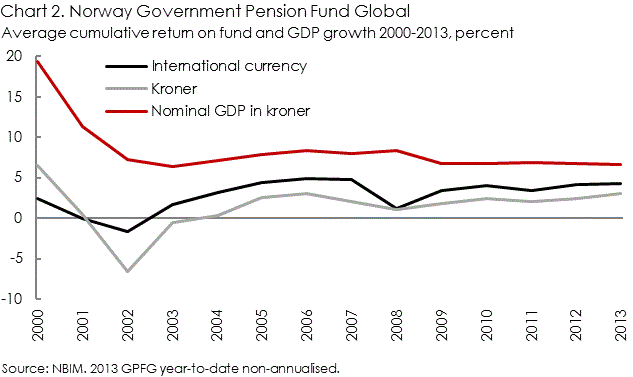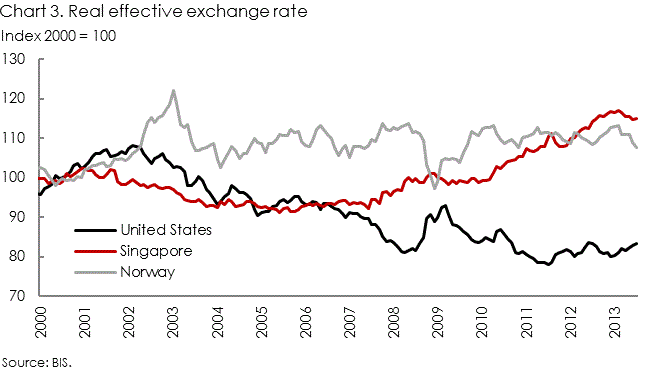Public financial corporations: Investment performance valuation and the exchange rate
20 September 2013
Ousmène Jacques Mandeng, Global Institutional Relations Group, Prudential Investment Management
The recent exchange rate jitters serve as an important reminder that exchange rates matter for investment performance attribution and consequently exhibit important wealth implications. This is of particular significance to government entities that perform international investment functions given the importance for government finance sustainability. Public financial corporations (PFCs), of which stabilisation funds and sovereign wealth funds constitute important subsets, generally aim to provide support for government finances through international financial investments.1 Investment performance of PFCs therefore constitutes a critical component of governments’ fiscal policies. Different practices co-exist internationally of performance valuations of PFCs in particular with regard to the exchange rate. Most PFCs conduct performance valuations in foreign currency terms. This note briefly aims to review key aspects of government finances to make the case that given pronounced long term exchange rate movements, investment performance valuation of PFCs should be presented in local currency to provide meaningful integration with the overall performance and financial position of the public sector and change in net worth. It also means that it may be harder for some PFCs than for others to make meaningful contributions to governments’ net worths.
Performance valuation of international investments, as is well known, is based on asset returns and exchange rate movements. Assuming that the co-variance between investment returns and exchange rate movements is significantly different than unity and covered interest rate parity does not hold, then the exchange rate represents a critical investment variable. Valuing an investment in foreign currency, abstracting from short-term currency volatility, exchange rate trends and/or long wavelengths in exchange rate fluctuations may cause significant performance differences: The S&P500 is up 50 percent on a total return basis between January 2000 and September 2013 in U.S. dollar terms; in Singapore dollar the return was 15 percent and in Norwegian kroner 12 percent (Chart 1).
PFCs like Norway’s Government Pension Fund Global (GPFG) and Singapore’s GIC have been established with an explicit objective to enhance the public sector’s net worth.2 Transfers from PFCs alter governments’ net borrowing needs contemporaneously or inter-temporarily. Performance targets are set and performance results of GPFG and GIC reported in a basket of currencies and in real U.S. dollars, respectively.3 The performance results may or may not be relevant within the context of government finances, that is, the impact of the performance of the S&P500 differs markedly for Norway and Singapore compared with a U.S. investor.
The integration of PFCs with other fiscal operations of the government is essential to measure the impact of government activity on the economy and the liquidity and sustainability of fiscal policy.4 The need for integrating PFCs and government budgets is well recognised.5 Government policy will be perceived as unsustainable if they cause a sustained reduction in the government’s net worth. Similarly, a sustained increase of net worth may favourably alter consumption and investment decisions of the rest of the economy. The government’s net financial worth, of which PFCs may constitute an important part, is determined by the PFCs’ asset performance, government transactions, including revenue minus expenditure and other economic flows that result in net lending or net borrowing of the government (government deficit). Monitoring the wealth impact of PFCs is therefore critical to assess whether the government adds to or withdraws resources from the economy or abroad.
PFCs foreign currency performance targets setting and reporting rest on the fundamental assumption that there needs to be symmetry between denomination of the investment universe and denomination of investment returns. The GPFG further argues that changes in local currency terms do not affect the fund’s international purchasing power.6 Both arguments are financially correct of course. However, they may not be relevant from an economic or fiscal point of view. In the case of the GPFG, the average annual rate of return in international currency (nominal) terms in 2000-13 was 4.3 percent; in local currency terms it was 3.1 percent. Norway’s nominal GDP on average has grown 6.6 percent per year over the same period (Chart 2). Therefore, the GPFG has contributed less to value added growth of factors owned by Norwegians (GNP) than its domestic component (GDP).7 This raises a question about the opportunity cost of maintaining the GPFG.
The exchange rate represents a key vehicle for wealth transfer with significant welfare implications proportional to net foreign assets held. Exchange rate movements produce both valuation effects—capital gains—from asset prices in addition to the traditional real effects through the current account.8 The U.S. has benefitted considerably from the sustained depreciation of the U.S. dollar since 2002 in real effective terms as it has led to an appreciation of its foreign assets (Chart 3).9 The opposite effect applies to countries’ holding U.S. assets.10 Norway’s real effective exchange rate has been relatively flat since 2002. However, the difference between the GPFG's return in international and local currency indicates that on average the GPFG transfers 1.2 percentage points per year—more than a quarter of its performance to the rest of the world—or today about 2 percent of Norway’s GDP per year.11 This suggests that GPFG’s lower return in local currency is due to larger investments in countries against which Norway appreciated in effective terms relative to the trade basket underlying Norway’s effective exchange rate. GIC during the past 10 years through March 2013 produced an average annual return in nominal U.S. dollar of 8.8 percent. Over the same period the Singapore dollar appreciated in nominal effective terms by 18 percent. This may but must not imply that performance in local currency was also significantly lower.12
Exchange rates may exhibit prolonged directional movements. The determination of long-term exchange rate movements has been associated with different determinants including the stock of net foreign assets, inter-country productivity differentials, commodity terms of trade and government consumption.13 Real exchange rate appreciation tends to be correlated with creditor countries (countries with large net foreign assets), countries with higher productivity growth in non-tradables versus tradables, positive terms of trade shocks due to income effects and countries with higher government consumption as governments tend to consume more non-tradable goods and services. While exchange rates are naturally also the outcome of monetary, exchange rate and other policies, longer-term trends are expected to be based mostly on underlying fundamentals. Changes in the international economy and increasing importance of emerging markets are expected to be supportive of pronounced long-term exchange rate movements.
The increasing importance of cross-border financial integration and possibility of sustained directional exchange rate movements underscore the significance of exchange rates for investment performance. Investment performance valuations in foreign currency may therefore be significantly different when stated in local currency. This matters in particular for PFCs given that they form an integral part of government finances. It seems reasonable to assume that in order to assess the economic impact of PFCs—the wealth effect—on the local economy investment performance ought to be set and reported in local currency. Investment performance per se is unlikely to be relevant for actual and future consumption and investment behaviour of the economy.
The relationship between investment allocation and investment performance in local currency terms implies that countries will differ significantly in their ability to deliver adequate investment returns in local currency terms. Investment allocations therefore may need to be more contingent on the home countries’ circumstances and what seem adequate returns for one country may not necessarily be so for another.14 Norway’s government may seek much higher returns for the GPFG but its relatively stable effective exchange rate helps. For Singapore it may be more difficult to perform well against an appreciating currency. Both GPFG and GIC may eventually come to the conclusion that subsidizing the rest of the world is not part of their mandate. Countries may argue though that such transfers are an insurance premium worth paying. Others may find that they have to make their assets work much harder.



1 The term public financial corporation, as specified in the IMF draft Government Finance Statistics Manual 2012, is preferred to sovereign wealth funds and other terms to express explicitly the link with other government entities and notion that such corporations form an integral part of government finances.
2 Government of Singapore Investment Corporation changed its name to GIC in July 2013.
3 For GPFG, “performance is measured in the currency composition of the actual benchmark index for the equity and bond portfolio (the investment portfolio’s currency basket),” Management mandate for the Government Pension Fund Global, governing documents as amended on 15 April 2013, www.nbim.no. The target return of the GPFG is set at 4 percent in real terms, NBIM, About us, www.nbim.no. GPFG also reports annual returns in krone. For GIC, performance is reported as a 20-year annualized real rate of return (nominal return minus global inflation). Results are also reported in nominal U.S. dollar terms.
4 References are taken from the IMF draft Government Finance Statistical Manual 2012.
5 The GPFG “is an integrated part of the government’s annual budget. Its capital inflow consists of all government petroleum revenue, net financial transactions related to petroleum activities, net of what is spent to balance the state’s non-oil budget deficit. This means the fund is fully integrated with the state budget and that net allocations to the fund reflect the total budget surplus, including petroleum revenue,” Government Pension Fund Global, www.nbim.no.
6 The Annual Report 2003 of GPFG manager Norges Bank Investment Management (NBIM) states that a “change in the krone exchange rate affects the Fund’s value in NOK but not the Fund’s value for Norway measured in terms of the possibilities of purchasing foreign goods and services in the future. The return measured in terms of foreign currency therefore provides a more correct picture of developments in the Fund’s international purchasing power than figures that include the effects of a change in the krone exchange rate,” www.nbim.no.
7 Gross national product (GNP) = Gross domestic product (GDP) + net factor income from abroad as can be approximated by the investment performance of the GPFG.
8 See e.g. Lane, P. and Shambaugh, J., Financial exchange rates and international currency exposures, NBER Working Paper 13433, September 2007.
9 The real effective exchange rate (REER) shows the nominal appreciation or depreciation of the home country’s currency relative to a basket of currencies normally weighted by import and export shares deflated by consumer prices (or other deflators) of the home country and partner countries. The REER rests on the assumption that as prices of tradable goods are equalised in world markets, price increases reflect price movements of non-tradable goods. The REER captures international purchasing power. On the calculation and interpretation of the REER see e.g. Chinn, M., "A primer on Real Effective Exchange Rates," Open Economy Review, 115-143, 2006.
10 See e.g. Tille, C., Financial integration and the wealth effect of exchange rate fluctuations, Federal Reserve Bank of New York Staff Reports, October 2005: “A growing body of research emphasizes the direct impact of exchange rate movements on the value of U.S. foreign assets […] When bonds are the vehicle of integration, the valuation gain from the depreciation of the home currency magnifies the benefit for the home economy by a factor of six.”
11 GPFG’s fund size is of kroner 4,566 billion (150 percent of GDP) in September 2013.
12 GIC does not publish returns in Singapore dollar. The performance difference would depend on whether the basket weights underlying Singapore’s effective exchange rate are similar to GIC’s investment allocation.
13 See e.g. Ricci, L., Milesi-Ferretti, G. and Lee, J., “Real exchange rates and fundamentals: A cross-country perspective, IMF Working Paper, January 2008.
14 The GPFG has already undertaken an important step by shifting from a market capitalization based government treasury bond index to a GDP-weighted government treasury bond index.